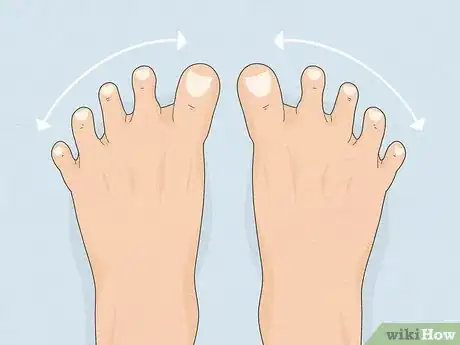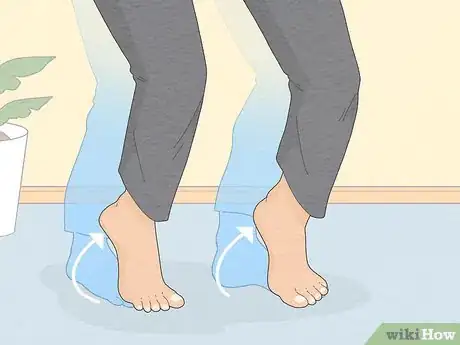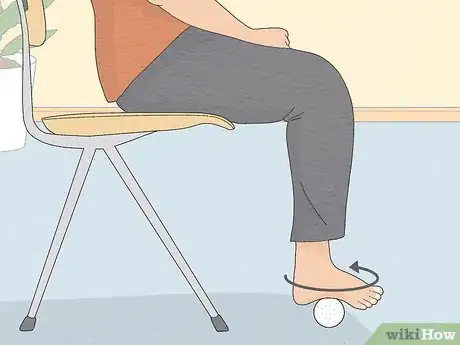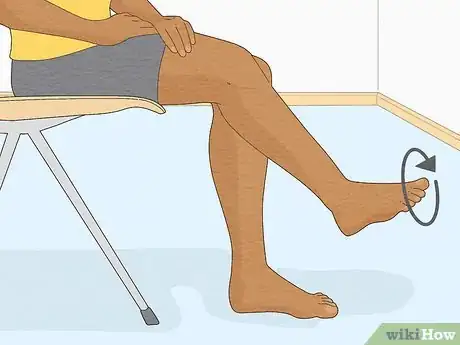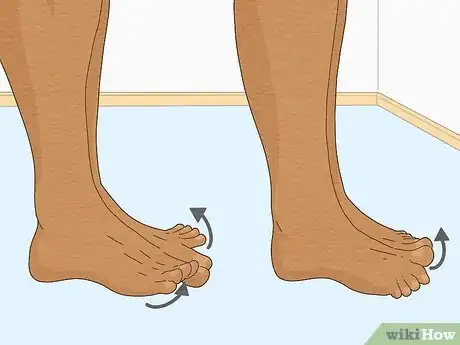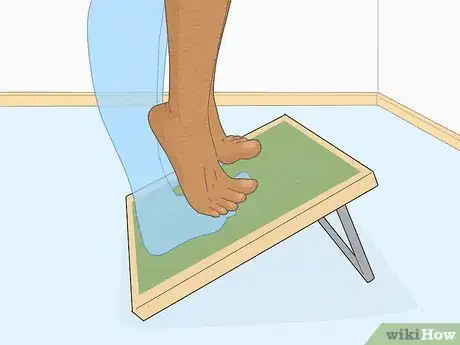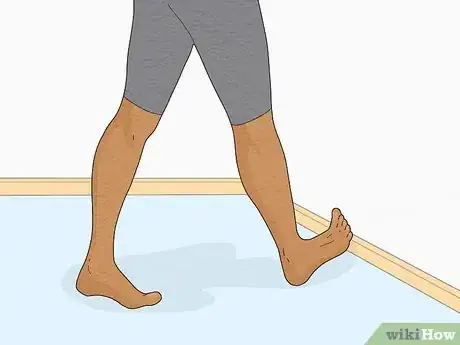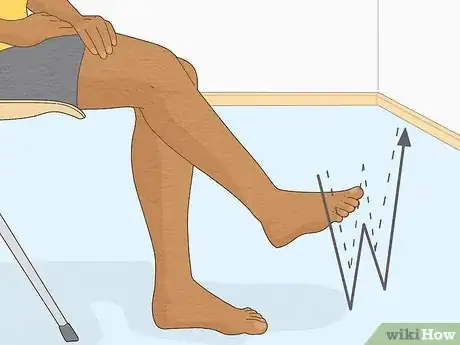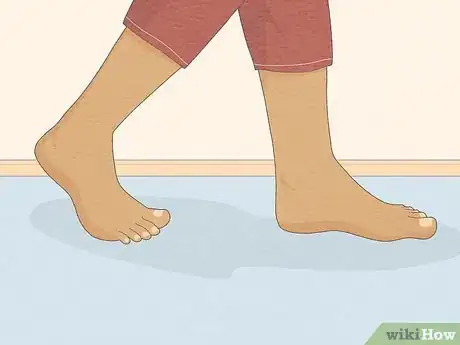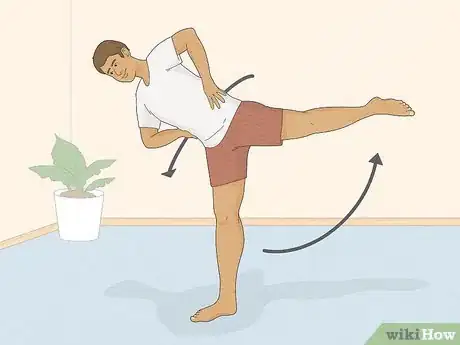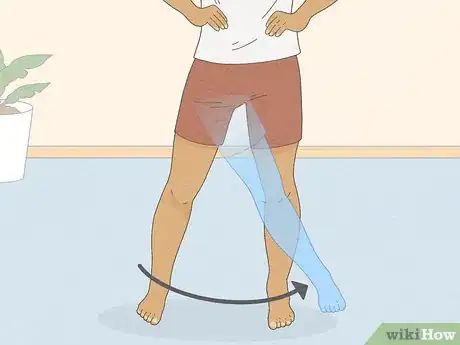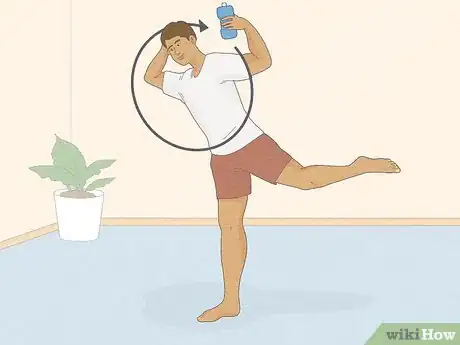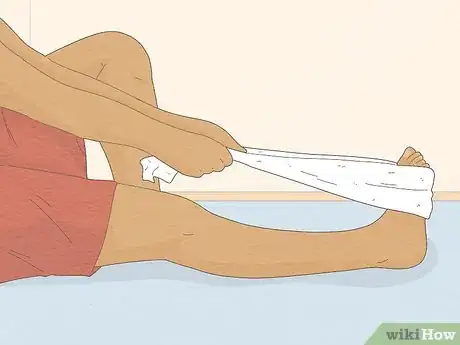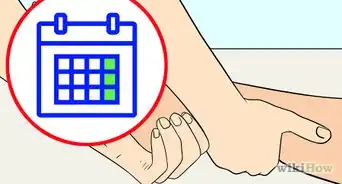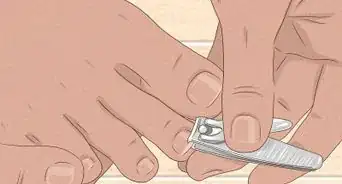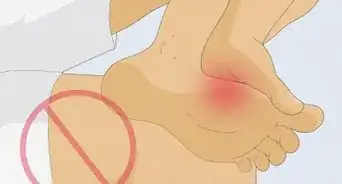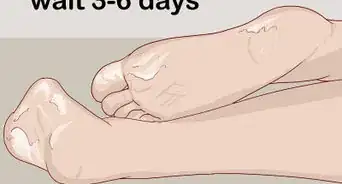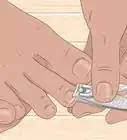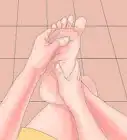This article was co-authored by Kai Ng and by wikiHow staff writer, Jennifer Mueller, JD. Kai Ng is a USATF and RRCA Certified Running Coach at Run Coach Kai. Kai has competed in over 55 races and over 15 marathons, and has trained with 16x USA and World record holder Patti Catalano Dillonso. He specializes in coaching runners of all levels and showing people that everyone can be a runner. Kai is committed to helping his clients reach their goals by showing them how to run with proper form and holding them accountable to train consistently.
There are 9 references cited in this article, which can be found at the bottom of the page.
This article has been viewed 7,252 times.
Even if you have a solid workout regimen, you'll get better performance if you dedicate just a few minutes of every workout to specifically exercising your feet. Strengthening your feet muscles reduces your risk of foot injury and can also make you a faster runner. Simply walking barefoot is the best exercise for your feet. However, if you want to make sure your feet are strong and stable, there are specific exercises that will increase the flexibility and stability of your feet.[1]
Steps
Raising Your Arches
-
1Contract the intrinsic muscles in your foot to lift your arches. The intrinsic muscles in your foot are all the tiny muscles throughout your foot that are responsible for movement in the soles of your feet. Sit on the edge of a chair with your knees at right angles and your feet flat on the floor. Your toes should also be flat and neutral on the floor — not curled or splayed out.[2]
- Try to shorten your foot by pulling the balls of your feet towards your heel so the top of your foot is domed. Hold the position for 5 to 10 seconds, then relax your foot back to the neutral position. Do 5 to 15 repetitions of this exercise.
- If you become adept at doing this while sitting, you can challenge yourself by doing it while standing, or even doing one foot at a time while balancing on one foot.
Tip: Once you get the hang of this exercise, you can do it several times throughout the day, even when you're sitting at your desk at work or school. However, you'll usually get more out of it if you're barefoot and can benefit from full sensory input from the bottoms of your feet.
-
2Splay your toes to activate your arches. Sit on the edge of a chair with your knees at right angles and your feet flat on the floor. Pull your toes apart as wide as they will go, paying close attention to your big toe. Try to move your big toe as far away from your other toes as possible. You'll feel the muscles of the arch of your foot contract. Hold the stretch for 5 to 10 seconds, then relax.[3]
- Start by doing 5 repetitions of this exercise. You can gradually build up to 25 or 30 repetitions, but start slow, especially if you haven't done any exercises specifically targeted toward your feet.
- Once you've been doing this exercise for a while, you can make it more difficult by doing it while standing.
Advertisement -
3Elevate your heels to strengthen the intrinsic muscles in your foot. Stand with your knees slightly bent and your feet about hip-width apart and your heels turned slightly in. Raise your arch, keeping your feet flat on the floor. Then, lift your heel off the floor until you are standing on your toes. Hold the position for 5 seconds, breathing deeply, then lower your heel to the floor.[4]
- Do 5 to 10 repetitions of this exercise. If you find it too difficult to do while standing, you can do it while sitting in a chair at first.
- You can also do one foot at a time, rather than doing both feet at once.
-
4Do golf ball rolls to condition the bottom of your foot. Sit tall on the edge of a chair with your knees at right angles and both feet flat on the floor. Place a golf ball on the floor and roll it up and down under the arch of one foot for 2 minutes. Then switch and do the same with the other foot.[5]
- Sit up straight while doing this exercise rather than leaning over your foot. Keep your foot close to the chair as you roll the ball back and forth, rather than rolling the ball outward.
Increasing Foot Flexibility
-
1Make circles with your big toe to limber up your feet. Sit on the edge of a chair with your feet flat on the ground and your knees at right angles. Lift one foot off the ground and make 15-20 circles clockwise with your big toe, then switch direction and do counter-clockwise circles. Put that foot down and repeat the exercise with your other foot.[6]
- Move your foot relatively slowly and deliberately. As you make your circles, pay attention to the movement of your foot and how it feels. Note any part of your foot where you feel a stretch — you may need to focus more attention there to make that area more flexible.
Tip: This is a good exercise to do to warm up your feet and get them ready for any other activity, but particularly for feet-specific exercises.
-
2Use toe yoga to separate the function of your big toe from your other toes. Sit on the edge of a chair with your knees at right angles and your feet flat on the floor. Raise your big toe off the floor as high as you can and hold it for 1 second, keeping your other toes flat on the floor. Then lower your big toe back to the floor while simultaneously raising your other toes as high as you can. Hold for 1 second, then lower your toes while raising your big toe.[7]
- Repeat the cycle for 2 to 3 minutes. Make sure you're sitting up tall with your shoulders back and breathing deeply. You can time your movements with your breath, raising on an inhale and lowering on an exhale.
-
3Stretch your toes and the bottom of your feet with calf raises.[8] Stand on a slant board if you have one (you can buy one wherever you buy sporting goods or fitness equipment). You can also lean a flat board against another object to create an angle — just make sure it's stable and will support your weight. Stand on the board with your toes higher than your heels. Lean forward slightly and raise on to your toes. Stay standing on your toes for a second, stretching the bottom of your foot, then lower back down to the starting position.[9]
- Do 15 to 20 repetitions of this exercise. Remember to breathe deeply throughout the exercise, moving in time with your breath.
- This exercise may prove difficult at first, especially if you haven't spent a lot of time strengthening your feet muscles. If you can't do the full 15 to 20 repetitions, start with 5 and work your way up.
Tip: You might find it easier to do this exercise if you have a bar or table you can hold onto for balance. However, make sure you're not putting any weight on whatever you're using for balance. Just use it to keep yourself stable.
-
4Try standing calf stretches to stretch your heels. Stand facing a wall with one foot flat on the floor and the other foot at an angle with your toes on the wall. Lean forward toward the wall until you feel a stretch in the calf and heel of your back leg. Keep the heel of your back leg pressed against the floor. Hold the stretch for 2 seconds, then release back to the starting position.[10]
- Do 5 to 10 repetitions of this exercise, then switch and do the stretch with the other foot.
-
5Add ankle stretches for maximum foot flexibility. Facing a wall, pull your feet together and place both palms against the wall so that your arms and back are straight. Press forward toward the wall, keeping your heels on the floor. You should feel a stretch in your calves. Hold the stretch for 2 seconds, then press back up to the starting position.[11]
- Do 5 to 10 repetitions of this exercise to stretch your calves and ankles. Make sure you're keeping your heels on the floor throughout.
-
6Write the alphabet with your big toes to improve your ankle's range of motion. Sit on a tall chair or stool so that your feet don't quite touch the floor. Leading with your big toe, draw the letters of the alphabet in the air. Repeat with the other foot.[12]
- Do 2 sets of this exercise with each foot. Keep your letters small so that you're using only your ankle and foot, not your leg.
Building Foundational Stability
-
1Walk barefoot more often to increase the overall strength of your feet. When you walk barefoot, you put your foot through its full range of motion. Walking barefoot more regularly will gradually strengthen the muscles in your feet as well as making your feet more stable.[13]
- Doing this can be as easy as taking off your shoes at home and walking barefoot around the house every day. You can also walk around outside, just make sure you're not walking barefoot in an area where you could step on something sharp and injure your foot.
Challenge: Walking on an uneven surface, such as sand or pebbles, will really give your feet a workout and improve your overall stability because your feet have to make micro-corrections to keep you upright with every step.
-
2Try bent-over twists to develop balance and control. This exercise challenges your balance. Stand on your right leg with your hands on your hips. Bend at the waist as you kick your left leg behind you until your leg and torso are parallel to the floor. Rotate your left hip toward the floor, back to neutral, then toward the ceiling. Repeat 7 more times, then switch to the other leg.[14]
- Do 3 sets of 8 reps with each leg. If your balance isn't yet strong enough to do this many reps, work up to it. Only do as many reps as you can handle with good form.
-
3Use small leg swings to work on hip and ankle stability. Stand on one leg with your arch raised so that the top of your foot is domed. Swing the leg you're not standing on forward and back 15 times. Then swing it left and right in front of the leg you're standing on another 15 times. Switch and do the same thing with your other leg.[15]
- Keep your swings short, about the distance from one shoulder to the other. All of your movement should be coming from your hips.
- This exercise challenges the stability of the ankle you're standing on as well as your overall balance.
-
4Add the press and pass-around exercise to maintain stability. Stand on one leg with a light weight in the opposite hand. You can bend your other knee to keep that leg close to your body or do whatever makes you feel most stable. Press the weight overhead 10 times, then pass it around your body 5 times clockwise and 5 times counter-clockwise. Switch and stand on the other leg, then repeat the exercise.[16]
- Repeat this exercise 3 times per leg. If you don't have light hand weights, a water bottle or other light object will do.
- The point of this exercise is not to work out the upper body, but to enable your foot to make micro-corrections that will ensure you remain stable as your body changes position. For this reason, the type of weight you use doesn't matter.
-
5Strengthen your calves and heels with a towel stretch. Get a towel, then sit on the floor with your legs straight out in front of you. Loop the towel around the ball of one foot, grasping the ends on either side of your leg. Pull the towel towards you until you feel a stretch in your foot. Make sure to keep your legs straight. Hold the stretch for 30 seconds, breathing deeply, then release. Repeat 3 times, then switch to the other foot.[17]
- Resist the urge to hunch over your legs while doing this exercise. Sit tall with your spine neutral and your shoulders back.
-
6Pick up a marble or a towel with your toes. For this exercise, you'll need at least 20 marbles and a bowl to put them in. Sit on the floor with your knees bent and both feet flat on the floor, then pour the marbles out in front of you. Pick the marbles up one at a time with the toes of one of your feet and place them in the bowl. Then repeat with the other foot.[18] [19]
- While marbles are traditionally used for this exercise, other small, hard objects will do if you don't happen to have any marbles lying around. For example, you could use small toys, such as LEGO bricks. Just make sure the objects you choose are all roughly the size of marbles and of uniform size.
Expert Q&A
-
QuestionAre there any other exercises that will help strengthen my feet?
 Kai NgKai Ng is a USATF and RRCA Certified Running Coach at Run Coach Kai. Kai has competed in over 55 races and over 15 marathons, and has trained with 16x USA and World record holder Patti Catalano Dillonso. He specializes in coaching runners of all levels and showing people that everyone can be a runner. Kai is committed to helping his clients reach their goals by showing them how to run with proper form and holding them accountable to train consistently.
Kai NgKai Ng is a USATF and RRCA Certified Running Coach at Run Coach Kai. Kai has competed in over 55 races and over 15 marathons, and has trained with 16x USA and World record holder Patti Catalano Dillonso. He specializes in coaching runners of all levels and showing people that everyone can be a runner. Kai is committed to helping his clients reach their goals by showing them how to run with proper form and holding them accountable to train consistently.
Certified Running Coach Compound exercises are great because they also develop other muscles that support your feet, like your calves. The big three are deadlifts, lunges, and squats.
Compound exercises are great because they also develop other muscles that support your feet, like your calves. The big three are deadlifts, lunges, and squats.
Warnings
- Talk to your doctor before starting a foot strengthening program to confirm that you are well enough for it, especially if you've had a foot injury in the past.⧼thumbs_response⧽
- Don't ignore pain. You may feel a light stretch in your foot while doing some of these exercises, but you should never feel pain. If a stretch or exercise is painful, stop doing it immediately.[21]⧼thumbs_response⧽
References
- ↑ https://www.health.harvard.edu/healthbeat/exercises-for-healthy-feet
- ↑ https://www.podiumrunner.com/training/time-for-things-that-take-time/
- ↑ https://www.podiumrunner.com/training/time-for-things-that-take-time/
- ↑ https://www.jospt.org/doi/full/10.2519/jospt.2016.0504?src=recsys
- ↑ https://orthoinfo.aaos.org/globalassets/pdfs/2017-rehab_foot-and-ankle.pdf
- ↑ https://www.health.harvard.edu/healthbeat/exercises-for-healthy-feet
- ↑ https://www.outsideonline.com/2291356/moves-to-strengthen-your-feet
- ↑ Kai Ng. Certified Running Coach. Expert Interview. 25 May 2021.
- ↑ https://breakingmuscle.com/fitness/5-foot-strengthening-exercises-to-improve-speed-power-and-balance
- ↑ https://www.nhsinform.scot/illnesses-and-conditions/muscle-bone-and-joints/exercises/exercises-for-foot-problems#standing-calf-stretch
- ↑ https://www.nhsinform.scot/illnesses-and-conditions/muscle-bone-and-joints/exercises/exercises-for-foot-problems#ankle-stretch
- ↑ https://orthoinfo.aaos.org/globalassets/pdfs/2017-rehab_foot-and-ankle.pdf
- ↑ https://www.health.harvard.edu/healthbeat/exercises-for-healthy-feet
- ↑ https://www.outsideonline.com/2291356/moves-to-strengthen-your-feet
- ↑ https://www.podiumrunner.com/training/time-for-things-that-take-time/
- ↑ https://www.outsideonline.com/2291356/moves-to-strengthen-your-feet
- ↑ https://orthoinfo.aaos.org/globalassets/pdfs/2017-rehab_foot-and-ankle.pdf
- ↑ https://orthoinfo.aaos.org/globalassets/pdfs/2017-rehab_foot-and-ankle.pdf
- ↑ Kai Ng. Certified Running Coach. Expert Interview. 25 May 2021.
- ↑ https://www.jospt.org/doi/full/10.2519/jospt.2016.0504?src=recsys
- ↑ https://orthoinfo.aaos.org/globalassets/pdfs/2017-rehab_foot-and-ankle.pdf

